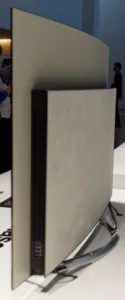At this year’s IFA show in Berlin (think CES for Europe), one of the big stories was the arrival of the first commercial OLED TV from Panasonic.

Panasonic’s curved OLED has a lot of circuitry on the rearAlthough Panasonic has shown (very impressive) OLED TVs before, they had just been design and development exercises and didn’t make it to production. The earlier ones were joint developments with Sony, and were based on an inkjet manufacturing process, but that project was terminated early in 2014.
The new Panasonic TV is based on an LG Display 65″ panel and that is a big endorsement of LG’s panel. Our friend and visual quality maven, Ray Soneira of DisplayMate, has always been a fan of the visual quality of the LG panel and that Panasonic is prepared to go to market with that component is also a big endorsement. Panasonic has a huge level of knowledge in video quality and processing and high quality standards, so the endorsement means a lot to me.
The history of OLED TV has been fraught with difficulties. Sony wowed us at the SID conferences in 2001 and 2002 with OLED TV prototypes and planned to be in volume production by 2003. It said it would be in the “volume TV market” by 2005. Eventually, it released a small set at a very high price, but it had little or no market impact.
By 2005, Samsung was demonstrating 40″ OLEDs (although said to be created from four 20″ panels). Samsung also made big news at SID 2010 when it made a keynote speech committing strongly to OLED TV and revealing that it had the intention of developing a G8 fab so that could compete with LCD for the large TV market. At the time, I wondered, in an editorial, why Samsung would try to do something quite so difficult.
The company took a really “purist” technology approach, by trying to combine RGB patterning of the OLED material with LTPS transistors. Both aspects represented significant technology challenges, even ignoring the issues of the time in product lifetime, driving schemes, “burn in” (the Sony TV shifted its colour after a lifetime measured in hundreds of hours) etc.
I covered the patterning issues earlier this year when there were rumours coming out of Korea that Samsung might adopt the white OLED approach (Is Samsung Looking at a Change in its OLED TV Plans?).
Samsung’s plan to make TV OLEDs using polysilicon transistors (rather than the amorphous silicon used by LCDs or the oxides used by LG in its OLED) was to allow a more complex pixel structure using up to seven transistors. LG uses just a single transistor according to a paper presented at last year’s SID, and so has to do a lot of processing work off the panel and feed the compensation that it needs to apply for manufacturing and lifetime issues back into the panel through the driving scheme. (We heard at IFA from several directions that Panasonic’s knowledge of display driving has been very helpful to LG, although it has also had input from other sources as well).
Unfortunately, making large LTPS is very difficult. LTPS is created by (and this is a simple version!) putting a layer of amorphous silicon on the glass and then melting it with a laser, applying just enough heat to melt the silicon but not the glass. As the silicon cools, it crystallises into a better structure for current flow, so you get better transistors. The problem is that it is extremely difficult to get the cooling to be very even and the bigger the substrate, the bigger the difficulty.
We have been reporting on LTPS since 1998 and although there has been continuous development of LTPS since then by many major companies, as far as I can remember, the only LTPS panel for a TV application was a unit made with an OCB LCD from Toshiba and used by Eizo in a very low volume (but very high quality) TV that was, as far as I know, only sold in Japan. That TV was only around 23″, although in 2004, there had been a plan to make 32″ as well. LTPS has been, since the ’90s, a technology that has really had its impact at 15″ and below. Today, the main application is for smartphone displays at FullHD and above.
However, Samsung had planned to go to 55″ and above with polysilicon – a huge technical challenge and it always looked to me like “a bridge too far”. It looks as though it may have been just too difficult, at least so far.
So Samsung, at IFA, was just showing LCD sets (which looked very good) and no OLEDs for TVs. But LG and Panasonic can both be happy that they seem to be able to make really good TVs based on OLED technology.
Bob

